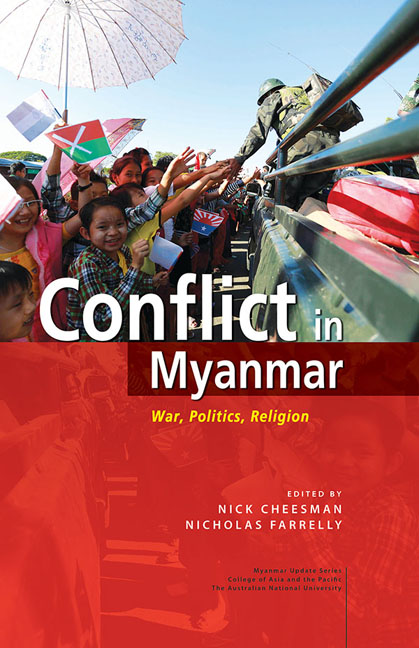Book contents
- Frontmatter
- Contents
- List of Maps
- List of Tables
- List of Figures
- Acknowledgements
- Contributors and Editors
- Part I Introduction
- Part II War and Order
- Part III Elections and After
- Part IV Us and Them
- 12 Making sense of reactions to communal violence in Myanmar
- 13 Public perceptions of a divided Myanmar: Findings from the 2015 Myanmar Asian Barometer Survey
- 14 On Islamophobes and Holocaust deniers: Making sense of violence, in Myanmar and elsewhere
- 15 Buddhist welfare and the limits of big ‘P’ politics in provincial Myanmar
- 16 Threat perceptions in the Myanmar–Bangladesh borderlands
- Part V Conclusion
- Abbreviations and Key Terms
- Index
13 - Public perceptions of a divided Myanmar: Findings from the 2015 Myanmar Asian Barometer Survey
from Part IV - Us and Them
Published online by Cambridge University Press: 22 July 2017
- Frontmatter
- Contents
- List of Maps
- List of Tables
- List of Figures
- Acknowledgements
- Contributors and Editors
- Part I Introduction
- Part II War and Order
- Part III Elections and After
- Part IV Us and Them
- 12 Making sense of reactions to communal violence in Myanmar
- 13 Public perceptions of a divided Myanmar: Findings from the 2015 Myanmar Asian Barometer Survey
- 14 On Islamophobes and Holocaust deniers: Making sense of violence, in Myanmar and elsewhere
- 15 Buddhist welfare and the limits of big ‘P’ politics in provincial Myanmar
- 16 Threat perceptions in the Myanmar–Bangladesh borderlands
- Part V Conclusion
- Abbreviations and Key Terms
- Index
Summary
A dominant image of Myanmar's politics is one of conflict. Whether it is the bloodshed over fighting in the Kokang region and the exodus of Rohingyas from Rakhine State, the struggle between young students against the police in protest, or the contestation among leaders and between democratic forces led by the National League for Democracy (NLD) and the Tatmadaw, the lens that frames Burmese politics is one of division. This was especially the case in the pivotal year of 2015, the year of the contentious November election that witnessed the decisive victory of the NLD.
Rather than examine underlying dynamics of specific issues or explore the causes of a particular conflict in depth, this chapter looks at conflict from the views of ordinary citizens. It uses the data from the Asian Barometer Survey (ABS) collected from January through March 2015 to shed light on how the public views cleavages in Myanmar society. The aim is twofold: to describe some of the empirical findings of the ABS related to conflict as well as to offer an alternative understanding of conflict drawing from a different data source — ordinary Myanmar citizens. different data source — ordinary Myanmar citizens.
The chapter examines public views of conflict generally and analyses how different groups in Myanmar society view conflict. Specifically, it concentrates on two different forms of political identity in Myanmar — ethnicity and religion — and examines the implications of responses to the ABS for understanding the causes and trajectories of conflict associated with these identities. Both cleavages are seen as underlying serious divides in Myanmar; ethnic differences have underscored decades of civil war and continued fighting between the Bamar majority and ethnic minorities, especially those concentrated in the states along Myanmar's borders. Religious differences, notably between the Buddhist majority and Muslim minority, have contributed to religious riots, hate speech, and religious intolerance in recent years (Cheesman and Htoo Kyaw Win 2015; Schissler, Walton, and Phyu Phyu Thi 2015). These divisions have been at the heart of conflict and violence in Myanmar.
By looking at public perceptions of conflict around salient political identities, as well as views related to conflict in general and by minorities, this chapter offers some surprising insights. While the ABS confirms the seriousness of division in Myanmar society, the findings suggest there is considerable common ground across communities for peace building and to reduce tensions.
- Type
- Chapter
- Information
- Conflict in MyanmarWar, Politics, Religion, pp. 261 - 284Publisher: ISEAS–Yusof Ishak InstitutePrint publication year: 2016

